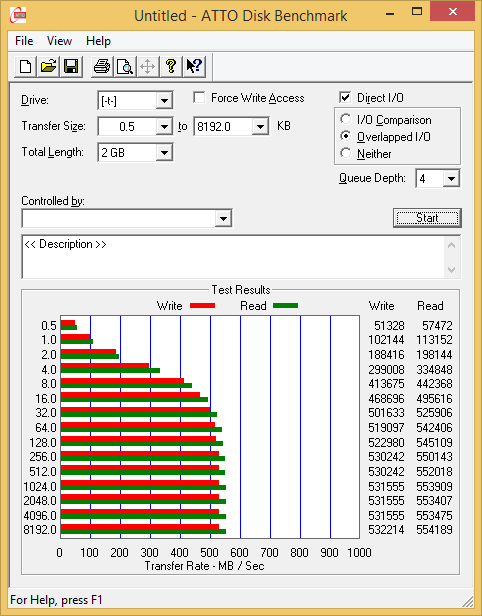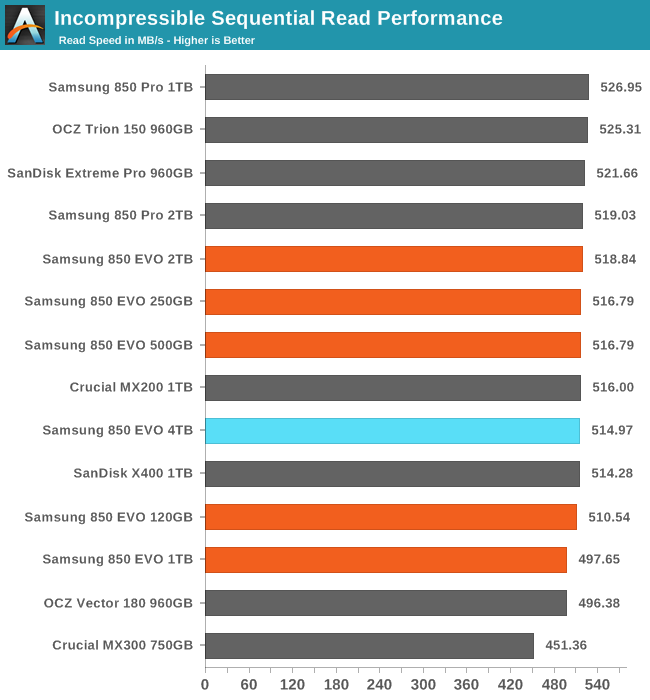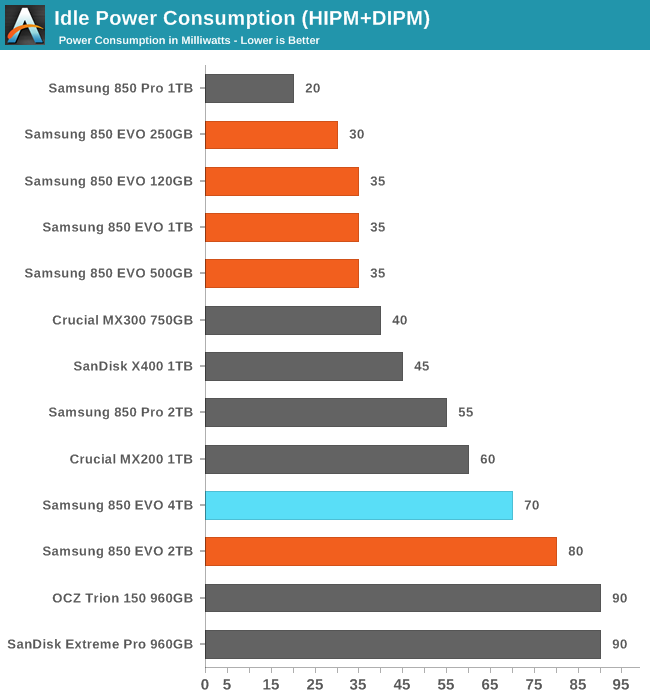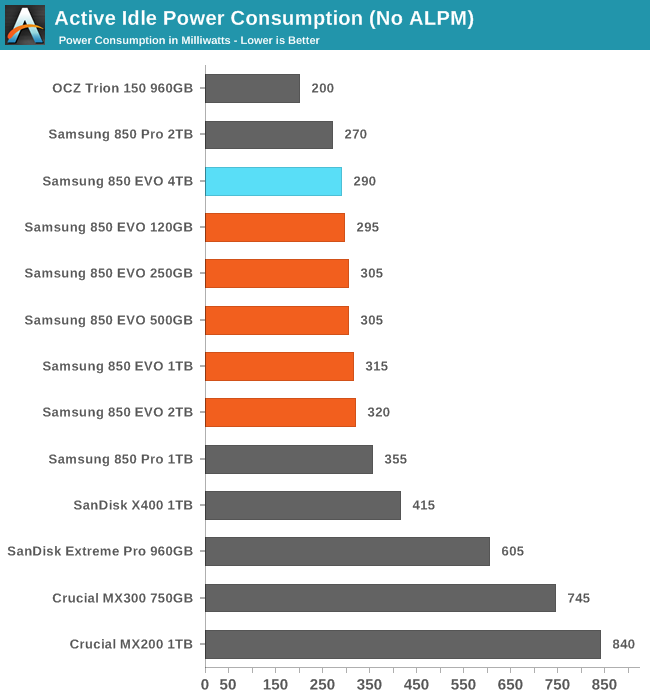The Samsung 850 EVO 4TB SSD Review
by Billy Tallis on July 11, 2016 10:00 AM ESTATTO
ATTO's Disk Benchmark is a quick and easy freeware tool to measure drive performance across various transfer sizes.
 |
|||||||||
The ATTO plot for the 4TB 850 EVO shows no problems and very slightly better read speeds than the 2TB 850 EVO.
AS-SSD
AS-SSD is another quick and free benchmark tool. It uses incompressible data for all of its tests, making it an easy way to keep an eye on which drives are relying on transparent data compression. The short duration of the test makes it a decent indicator of peak drive performance.


As expected, the AS-SSD results are unremarkable. Even if the new V-NAND were slower, the 4TB drive has more than enough parallelism to provide peak performance that saturates the SATA link.
Idle Power Consumption
Since the ATSB tests based on real-world usage cut idle times short to 25ms, their power consumption scores paint an inaccurate picture of the relative suitability of drives for mobile use. During real-world client use, a solid state drive will spend far more time idle than actively processing commands. Our testbed doesn't support the deepest DevSlp power saving mode that SATA drives can implement, but we can measure the power usage in the intermediate slumber state where both the host and device ends of the SATA link enter a low-power state and the drive is free to engage its internal power savings measures.
We also report the drive's idle power consumption while the SATA link is active and not in any power saving state. Drives are required to be able to wake from the slumber state in under 10 milliseconds, but that still leaves plenty of room for them to add latency to a burst of I/O. Because of this, many desktops default to either not using SATA Aggressive Link Power Management (ALPM) at all or to only enable it partially without making use of the device-initiated power management (DIPM) capability. Additionally, SATA Hot-Swap is incompatible with the use of DIPM, so our SSD testbed usually has DIPM turned off during performance testing.


The 4TB EVO has slightly lower idle power consumption than the 2TB EVO, but both still draw twice as much power in the slumber state as the smaller 850 EVOs with the MEX and MGX controllers.










145 Comments
View All Comments
Eden-K121D - Monday, July 11, 2016 - link
Too Expensive. $999 would have been a sweet spot and a potential option for meZak - Monday, July 11, 2016 - link
The price will come down. Eventually.Ratman6161 - Monday, July 11, 2016 - link
Doesn't really mater if the price goes down, its still a niche product. The EVO's are great general purpose desktop drives. But the people who need a general purpose desktop drive, mostly don't need 4TB and would not buy one at $500 let alone at $1500. In my case, I've got a 250GB Evo and a 1 TB spinning disk for storage of music, pictures, video etc. So I guess a cheap enough 2 TB SSD could work for me just because it would be marginally easier to not have two separate chunks of storage to deal with...but thats just a marginal increase in convienience. The stuff I have on a spinning disk doesn't really need the performance of an SSD anyway.I know, now someone will jump in with "well I sure need that 4 TB" but I still say that isn't the norm. I really don't believe they will sell very many of these compared to the 1 TB and below even if the price comes down.
Meteor2 - Monday, July 11, 2016 - link
I don't need it. But it's exciting to see this progress in SSDs. It'll take a while but mass production will bring the price/size ratio down.Impulses - Monday, July 11, 2016 - link
OTOH lack of competition will probably counter that to an extent... But I'm glad it exists too, if nothing else it might mean more sales on the 2TB. :pleexgx - Sunday, August 7, 2016 - link
was so funny when i clicked on 25% OP, but really the extra OP is really only needed for places where your writing constantly as normally the drive is Trimmed (most SSD/HDDs life is read then write, unless in a server setup that does lots of writes) the drives normal hidden OP is what 400-500MB ?beginner99 - Tuesday, July 12, 2016 - link
Agree. This shows that HDDs are here to stay for another decade. The same for 4 TB in form of a HDD can be had for about $130. So that 1/10th of the SSD price and as you said for media files, you don't need an SSD at all.Impulses - Wednesday, July 13, 2016 - link
Another decade? That seems like a stretch unless you're hoarding BD tips and the like... A decade ago we didn't even have SSDs.joex4444 - Tuesday, July 19, 2016 - link
If you have 4TB of stuff to store and it's mostly media that is accessed infrequently, it would only make sense to buy a 4TB SSD over a 4TB HDD if the prices are comparable. We've technically had SSDs for decades, it's just that they used to be in the millions of dollars per drive rather than $100 or so. Exactly how production will change to make 4TB drives cheaper isn't clear. It could be that we've already reached the lowest price per GB and all that remains is to have that scale linearly. This would mean that if 250GB drives cost $60, then a 4TB drive should cost 16 times that, or $960. Maybe some kind of discount could bring it into the $750 range, but in order to get down to $130 we need significant changes. That would put a 250GB drive on the order of $25.JimmiG - Wednesday, July 13, 2016 - link
Of course it's not "needed" right now, but it's nice to see progress. The 6 GB HDD I used in my Pentium system was plenty at the time - I didn't "need" those fancy new 20 GB drives...